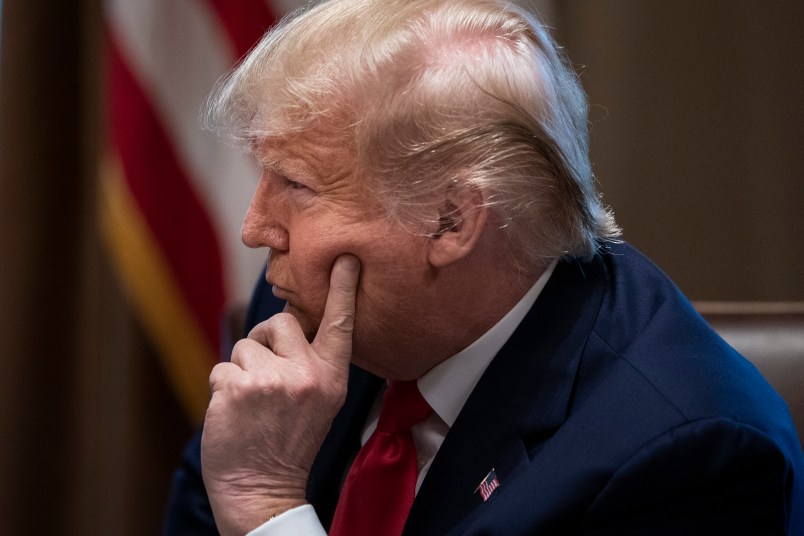There’s a lot unknown about how best to mitigate the economic fallout of the growing coronavirus outbreak. But what has brought agreement among several economic experts is that the payroll tax holiday President Trump is currently pushing is an ineffective and inefficient way of dealing with any economic disruption COVID-19 causes.
While such a measure has been employed in previous economic slowdowns, the particular economic risks that coronavirus poses — where people are going to be pulling back spending on travel, entertainment events, and other public outings — make a payroll tax cut ill-designed for the current circumstances.
“With a payroll tax cut, they’re still not going to want to do those things,” said Dean Baker, the co-director of the Center for Economic & Policy Research.
Pay roll tax holidays have been employed in other situations when overall demand has decreased, like after the financial crisis of 2008. But it won’t help in situations where the reason people aren’t spending in industries like travel is because of public health, several experts told TPM.
“This time aggregate demand is sinking for very targeted and specific reason,” said Bill Spriggs, a Howard University economics professor and the AFL-CIO’s chief economist. “Things like a payroll tax, they aren’t going to relieve the issue.”
Trump touted the payroll tax cut idea in his Oval Office address Wednesday night and had previously pushed it behind closed doors at a Senate GOP lunch on Tuesday, where it got a cool reception. Many of the details remain unclear, but an elimination of the tax through the rest of the year would cost the government $700 billion.
“It’s just a poorly targeted way to spend a lot of money,” said Howard Gleckman, a fellow at the Urban-Brookings Tax Policy Center who edits the fiscal policy blog TaxVox.
He said the extra cash wouldn’t be going to the people most vulnerable, such as those who lose their jobs in the travel industry or because of schools or venues closing. Those who did get the financial boost would be unlikely to change the behaviors that were causing a slowdown.
“Would [the extra money] be enough to convince them to buy airline tickets? Probably not,” Gleckman said.
Beyond just being ineffective, a payroll tax cut could have “perverse incentives,” according to Simon Johnson, an economics professor at MIT.
Because Americans will need to be getting a paycheck to receive the benefits of the tax holiday, workers — particularly those who can’t telework, or don’t have access to paid sick leave — will be have an incentive to continue to show up to work even if they are ill.
Another unintended consequence, according to Spriggs, is that Americans who receive the extra cash would then spend it at online retailers, rather than the brick and mortar stores that will be taking a hit as people avoid public spaces.
“If I buy something [online] instead of going to the mall, I am not going to buy it again when this abates,” Spriggs said.
What makes it difficult to respond to this current situation is that it’s unclear whether economic fallout will remain limited to the specific industries most affected by coronavirus or it will spread through the entire economy. Some economists told TPM it might make sense to prepare for more broad-based proposals, in case the latter scenario ensues, but more immediately, the government should put in place measures more targeted at the places were the effects of coronavirus are more certain.
Such proposals include paid sick leave (as Democrats are proposing), which brings an important public health benefit, or increasing the federal government’s Medicaid spending, which will help the local and state governments that are on the front lines of dealing with the current crisis.
If the government ultimately has to turn to more generalized measures, there are other reasons why economists are skeptical of a payroll tax cut.
For one, the benefit gets bigger as one’s paycheck gets larger, so it is not the most efficient way to get financial assistance to the people who will need it most, such as hourly workers or those who lose their jobs altogether.
“Too much of it leaks out to the [relatively] high income people who don’t need the help and won’t spend it,” said Josh Bevin, the director of research at the Economic Policy Institute. He also argued the benefit will come at too slow a pace to mitigate what could be a sudden disruption to the economy,
For those reasons, some economists are proposing that the government just write checks that would go to every U.S. taxpayer. That’s similar to how the George W. Bush administration dealt with the 2008 financial crisis, when it sent 130 million taxpayers rebate checks up to $600 for individuals.
That idea does not appear to be on the White House’s radar yet, however. Instead, they’re hinting at the type of payroll tax holiday that will exacerbate many of the concerns economists have about the proposal. Specifically, Trump advisors have said that they want the cut to apply to the employer side as well.
That would be just a pure windfall to businesses, Bevins said, which would probably not be inclined to pass that along to workers, particularly as demand slowed.







Trump really looks like shit lately.
And how does this help people without jobs?
It doesn’t.
We will just call them moochers… DJT and Mitt
?
" Brazilian spokesperson tests positive for COVID-19 after he meets with Trump and Pence at Mar-a-Lago"
The whole payroll tax cut is just a trojan horse to undermine Medicare and SS, does nothing to help the laid off or furloughed workers. Any Democratic congressman supporting this charade should be driven out of town on a beam after being tar and feathered.
B…b…but tax cuts cure everything.